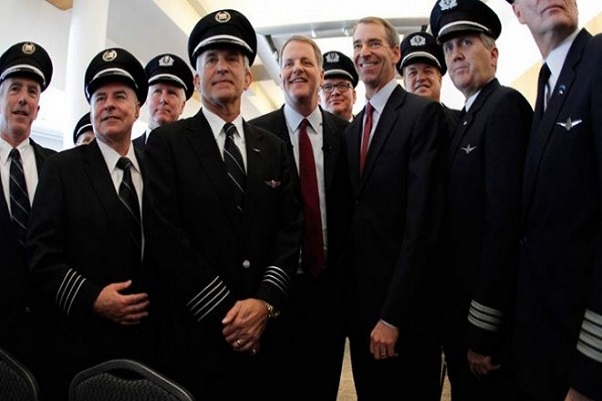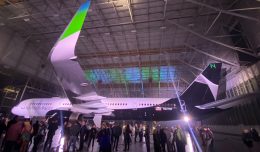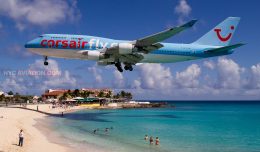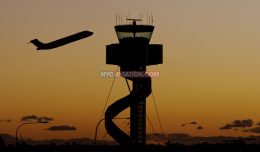Now that the merger between American Airlines and US Airways has closed, we’ll take a look at how this newly formed mega-carrier will operate, specifically, from the pilot’s point of view.
Mergers in the airline industry are certainly not a new concept. In reality, it’s tough to find a current airline employee who hasn’t experienced at least one merger first-hand, and many have been through multiple mergers. What is new this time around is the sense that this merger between American and US Airways is being received by most involved with open arms, or at least an open mind, which, given the combined history of the airlines involved, says a lot.
The American Airlines and US Airways that existed prior to this week’s merger were both products of previous mergers, so the optimism regarding the New American Airlines cannot be fully appreciated until we understand the past.
West meets East
Without a doubt, the largest collective sigh of relief this week came from the middle of the desert southwest. Phoenix to be exact. This is where the former America West pilots have been dug-in for more than eight years, battling it out with pilots and their union from the former US Airways, in an effort to enforce an arbitrator’s ruling regarding the one thing that some pilots have compared to Superman’s Kryptonite: Seniority.

Although America West and US Airways merged in 2005, pilot groups from both airlines still maintain a split personality.
Seniority is everything to an airline pilot. It determines when a pilot will fly, how often, what routes, which equipment, and how much they will be paid. Seniority also determines which seat they will occupy in the cockpit, and how long they will have to wait to move into the left seat.
In 2005, a financially solvent America West Airlines bought US Airways out of bankruptcy, creating one larger airline that kept the US Airways name. At the time of the merger, the pilots from each airline were represented by the Air Line Pilots Association, known as ALPA. The America West pilots felt that because their airline rescued US Airways, the “West” pilots should at least get a fair blending in the seniority list with the “East” pilots. However, the East pilots saw things a bit differently, and thought that seniority should be determined by date of hire, which would have benefitted the East pilots more than the West because of the fact that US Airways is the older carrier, and thus many of its pilots have earlier hire dates.
The seniority battle between the East and West pilots went to arbitration, and in 2007, a blended seniority list was created, called the Nicolau Award, named for its creator, George Nicolau. This new binding seniority list didn’t sit well with the East pilots, as it placed some West pilots with later hire dates, but more longevity (actual time on the job, as opposed to being furloughed), ahead of some East pilots, many of whom had earlier hire dates than West pilots, but were furloughed at the time of the merger. The West pilots accepted the Nicolau list, however, it wasn’t considered an all-out victory because of the fact that the East pilots were awarded the top 517 slots on the list, and the most senior West pilot was at number 518.
The US Airways pilot group was twice the size of the America West pilot group at the time of the merger, so subsequently, and some would say illegally, the East pilots never adopted the Nicolau Award, and voted out ALPA as their union, and formed a new union. The US Airline Pilots Association (USAPA) became the bargaining group that purportedly would represent all of the combined pilots, much to the chagrin of former America West pilots, who felt that USAPA would not fairly represent them.
Up until this week, the two pilot groups at US Airways have had separate contracts, which meant that they were still essentially two separate airlines. The West pilots could not bid flying that was held by the East, nor could they fly each other’s aircraft. Neither pilot group has had a pay increase since before the 2007 merger.
Management at US Airways stayed at arms length from the dispute, hoping that the pilots would sort their differences out by themselves. The real worry came when the merger talks with American Airlines began. The America West pilots group filed a lawsuit against USAPA, saying that they were not being fairly represented because of the failure by the union to implement the Nicolau Award. USAPA filed a motion in bankruptcy court, asking the court to prevent the former America West pilots from taking legal action to stop the merger.
When asked about his thoughts on the new merger, and the possibility of new union representation by the Allied Pilots Association (APA), which is the current pilot’s union at American Airlines, US Airways Captain Eric Auxier had this to say: “I fully expect APA to do the honorable thing and abide by whatever arbitrated agreement emerges, contrary to USAPA, which was created for the purpose of reneging on its legally binding obligation to honor the USAir seniority list. For this very reason, USAPA was found guilty of DFR (Duty of Fair Representation) by unanimous jury verdict.”
Regarding which list the New American Airlines should use, Auxier says: “There is one legal seniority list, the two pilot groups hammered it out, the arbitrator presented it, the pilot groups accepted it, they presented it to the company, the company accepted it, so that’s the list that we hold to and USAPA is fighting to steal that list and present their own list to their advantage and our disadvantage.” Representatives from USAPA did not answer our request for comment on this matter.
The reason for optimism among the former America West pilots this time around is found in the likelihood that USAPA will be replaced by APA, and pay rates for all US Airways pilots will immediately increase to be in line with the current pilots at American.
Meet me in St. Louis
While the biggest issue from the pilot’s perspective is that of seniority, specifically between the East and West pilots, I spoke with a current First Officer from American, and wanted his opinion on the merger. He is optimistic, but he certainly didn’t mince any words when talking about American’s past: “As a pilot for American, I’m thrilled for a number of reasons, largely because I was never impressed with the American management, they really blew some opportunities. They had tremendous opportunity when they merged with TWA… any routes in the world, and they flushed that down the toilet. [They had] the facilities, people, and equipment to do amazing things, and didn’t. They just have people now, nothing else to show for it.” He went on to say: “After 9/11 they had a tremendous opportunity. 9/11 presented a unique time. Every employee rallied behind the airline, willing to do anything to make the country and the airline survive. They [the company] rewarded themselves and punished everyone else. They blew a chance to have employee support.”
When asked about the pilot groups combining under a single union and contract, he said “As pilot, I am enthusiastic, optimistic, but also nervous about getting involved in what has been a “Colossal Mess” between the pilots at US Airways. I am pleased that the West pilots will finally have pay parity with the pilots from US Airways East.”
The 2001 merger between American Airlines and TWA was not without it’s own pilot conflict, however, the issue of pilot seniority was resolved early in the merger process, that is, until just recently. When American Airlines filed for bankruptcy in 2011, one of the caveats of the reorganization plan was that American would close its pilot base in St. Louis (STL). The problem with that plan is that the pilot base at STL was stipulated in an agreement between American and APA known as Supplement CC. This agreement provided protection for the former TWA pilots based at STL, who didn’t fare very well in the combined seniority list, which the APA adopted after the 2001 merger.
The seniority list had 2,500 American pilots at the top, followed by approximately 1,000 TWA pilots blended in with American pilots at a 1:9 ratio, which meant one TWA pilot for every nine American pilots. The balance of the TWA pilots were placed near the bottom of the list, just above any new hires by American.
As a result of arbitration, the TWA pilots were given protected positions in Dallas (DFW) and Miami (MIA), but they are not going to retain what some have called “super seniority” after they move out of STL. American has one seniority list, top to bottom, just like most other airlines. However, in STL the former TWA pilots got to choose lines of flying and vacation above native pilots who were based at STL. The TWA pilots were given positions at DFW and MIA, but will have to use their company seniority number for bidding purposes.
The American pilot I spoke with said that this time around, the union leadership is more likely to negotiate with the company, rather than draw a line in the sand, which is what the former president of the APA did prior to American filing bankruptcy in 2011. He was subsequently voted out of office.
Both pilots I spoke with are cautiously optimistic about the new merger, and hope that cooler heads will prevail in the integration of the new seniority list. There are a lot of moving parts to this equation, and if any pilot group digs their heels in during negotiations, as one pilot puts it, “things will go bad fast.”
Ken McQuillan is a contributor to NYCAviation.com, and an aerial photojournalist, based in Detroit, MI. Follow Ken on twitter @FlyingCinematog








